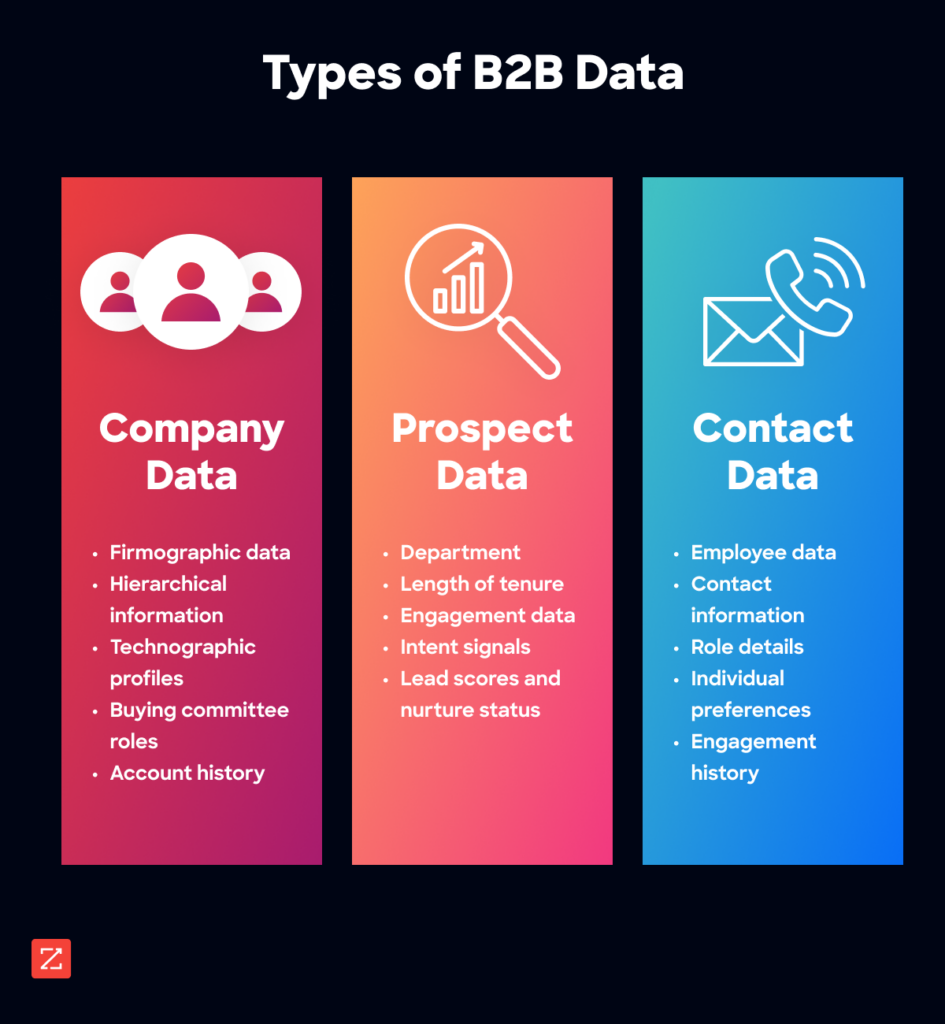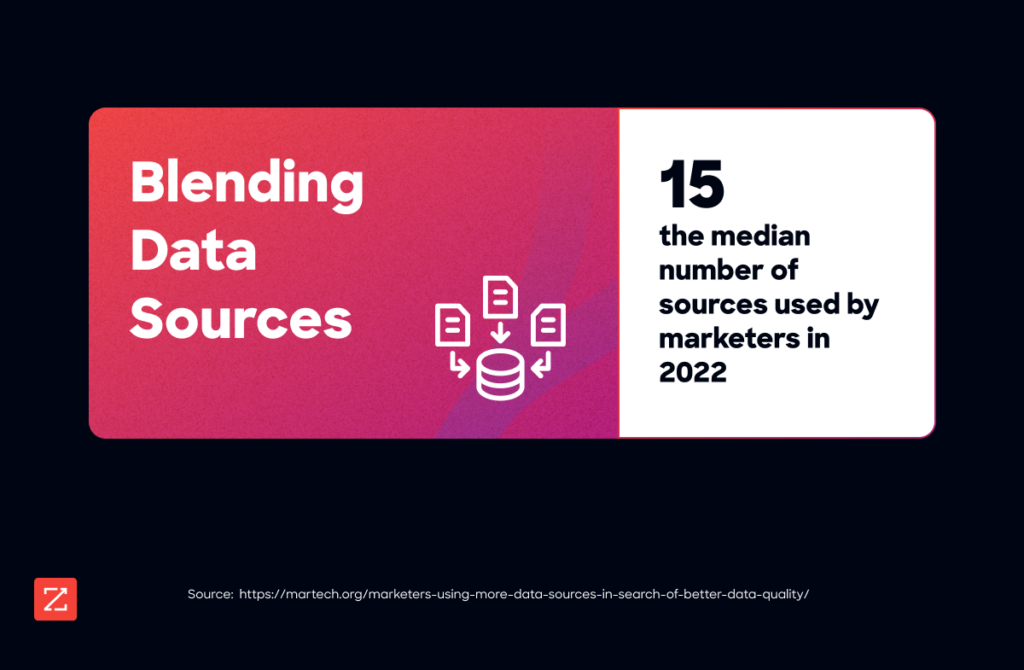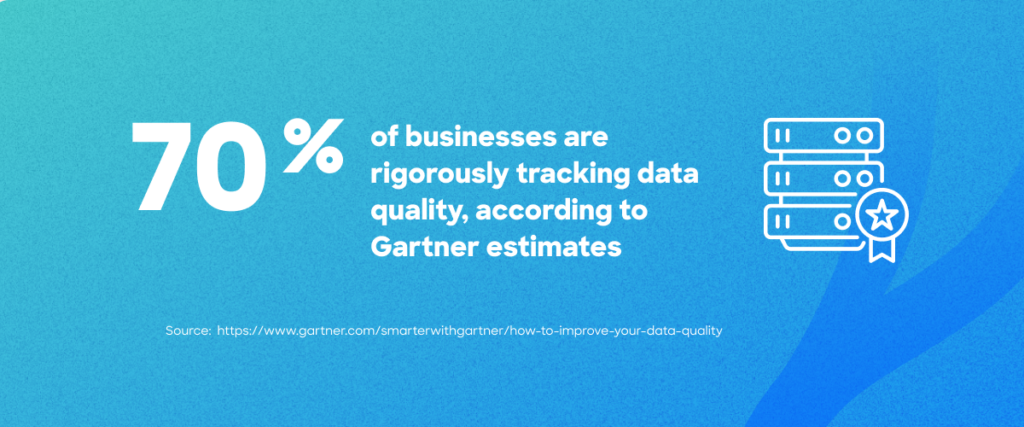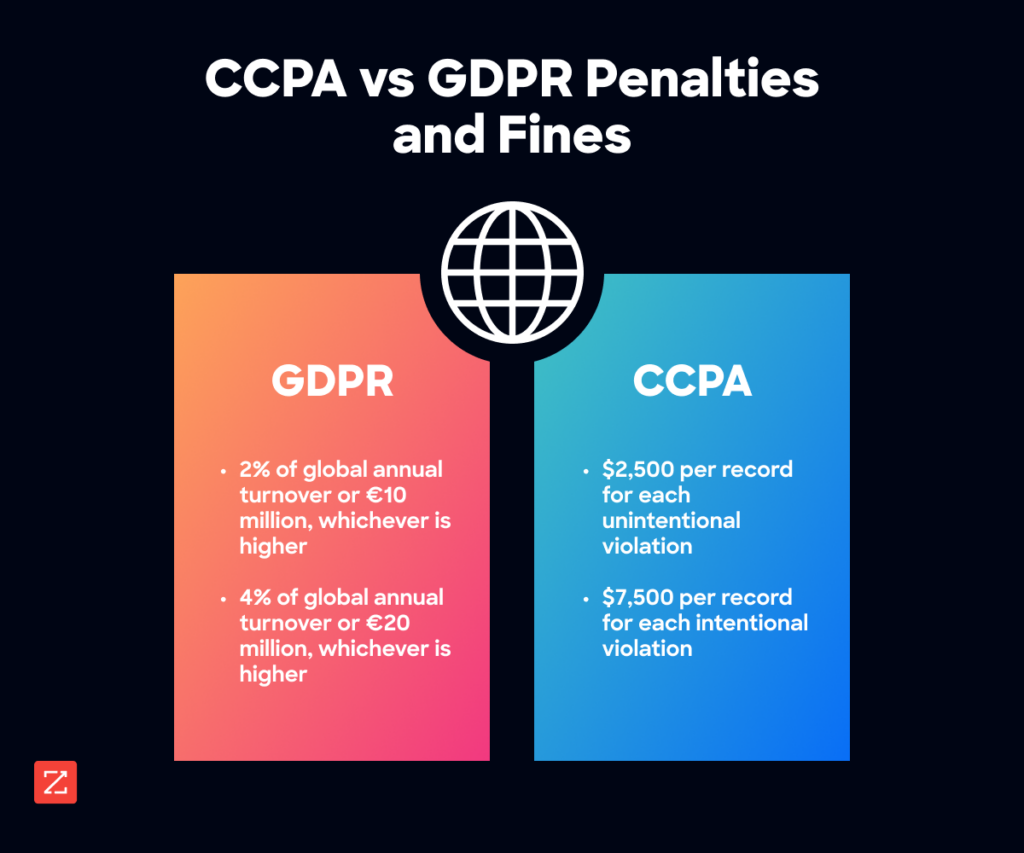Data touches every aspect of modern business, from lead generation and email marketing to customer relationships, sales enablement, and revenue growth. To make informed decisions, leaders need trusted insights based on high-quality B2B data.
B2B data comes in many forms, from many sources. It needs to be handled appropriately and well-maintained to provide valuable insights for marketing or sales teams.
What is B2B Data?
B2B data is business-to-business information relating to potential clients that can be used to drive sales and marketing efforts. Examples include:
Basic company information
Contact lists of sales leads and key decision-makers
Demographic data
Buyer intent data
Customer relationship and engagement data
Market and competitor data
B2B data comes from a variety of sources, including specialized data providers, analytics platforms, and internal CRM tools. Because most data points are quantifiable, B2B data can be deployed in a variety of metrics and workflows.
What is B2B Data Used for?
For marketing and sales teams, gaining a full understanding of potential customers is vital for campaign success. Quality B2B data builds the foundation for these efforts.
TAM and ICPs
In businesses that use account-based marketing (ABM), B2B data helps marketers create personalized experiences that remain consistent across different platforms and contacts. Similarly, sales-led businesses can use B2B data in sales enablement, giving reps the information they need to engage with prospects.
Outbound Sales
When B2B marketers and sales professionals reach out to targets, data provides the basis for lead qualification. As leads hit required criteria and enter the funnel, sales teams can use B2B contact data to make the first move.
Automation
Each of the processes and tools mentioned above can significantly improve the efficacy of your marketing and sales campaigns.
Types of B2B Data
The sheer variety of B2B data available can seem a little daunting to those tasked with organizing it. However, it’s possible to group the majority of data points into three categories.

Company Data
Before labeling a business or account as a prospect, you have to know something about them. Company data is used by marketing and sales teams to build detailed ICPs.
ICPs can include:
Firmographic data. For example, the industry, number of employees, annual revenue, and locations of a given company.
Hierarchical information. This details any parent-subsidiary relationships.
Technographic profiles. What software, tools, and technologies is a company using? It’s a good idea to keep a record of the company website.
Buying committee roles. Who is the economic buyer? Who is the executive sponsor?
Account history. If the company is a returning prospect, take note of past purchases, outstanding quotes, and support tickets.
Prospect Data
Having identified potential new customers, the next step is to collect and analyze prospect data, specifically for the individuals or teams who may be making purchase decisions at your target companies.
Key prospect data points include:
Department. Where do they work within the company?
Length of tenure. Are they new to the role or well-established?
Engagement data. Such as emails opened and event sign-ups.
Intent signals. Searched keywords, pages visited, content downloads, etc., can signal when a business is actively looking for a solution.
Lead scores and nurture status. These are based on activity, and how well the prospect fits with your ICP.
Contact Data
Turning prospects from qualified leads into customers often involves engaging with a specific person in a target company. Contact data for these individuals can include:
Employee data. Name, job title, department, and location.
Contact information. Their email address, direct phone number, and LinkedIn URL.
Role details. This encompasses their decision-making authority and amount of budget control.
Individual preferences. The specific challenges they face and insights from behavioral data.
Engagement history. All previous touchpoints, across marketing, sales, and service departments.
Accurate contact data enables personalized, one-to-one marketing and high-touch sales interactions.
Sources for B2B Data
As a general rule, customer insights come from blending together data from internal systems and external providers. Using multiple sources is necessary for building a complete picture and desirable for ensuring that data is reliable.

Internal Sources
A great deal of B2B data is generated internally through everyday operations. CRM and sales databases, marketing automations, and customer service records all contain a significant amount of useful information.
Data from existing website analytics and lead capture form fields can yield prospect behavior insights, while event registrations, webinar signups, and other demand generation interactions indicate what prospects are interested in.
It’s also possible to gather information from surveys and customer feedback — in particular to capture the views of potential customers toward your brand.
External Sources
Other external services include technographic data partners, dedicated B2B data enrichment tools, data exchanges, data co-ops, and public sources, such as news websites and trade publications.
Emerging Sources
In technology, the internet of things (IoT) can collect usage telemetry, performance metrics, and customer behavior insights for smart devices. Even review sites are becoming a key source of data. With automation, marketers can run sentiment analysis on site comments from users and customers.
The Importance of Reliable B2B Data
Given the potential benefits of B2B data delivering actionable insights, businesses often fall into the trap of focusing on quantity over quality.
But in this case, more is not better than good. Inaccurate, outdated, or incorrectly formatted records are likely to cause problems throughout your sales and marketing operations.
Worse still, you could make key strategic decisions based on insights derived from incorrect information. According to Gartner research, this problem costs businesses $12.9 million per year on average.
In other words, data quality is very important. It’s vital for companies of all sizes to embrace data maintenance.

What is Data Maintenance?
Data maintenance means practicing good data hygiene, including:
Normalization
Appending
Cleansing
Data Normalization
Data normalization is the process of standardizing values in your database. This creates relativity and context by grouping similar values into one common value. Any data point can be normalized. Examples include job title, job function, company name, country, state, and industry.
Data normalization may sound simple, but collection processes often complicate things. Consider the following:
Manual Data Entry
Expect errors and discrepancies whenever there is manual data input, e.g., someone filling in a form on your website, a salesperson doing their own prospecting, or an events manager entering data from business cards. Each person will have their own set of abbreviations, capitalization methods, and spelling errors.
Multiple Names for the Same Data Point
There are many different ways to say the same thing. Think of states, Connecticut is the same as CT, or job titles, a content marketing manager is the same as a marketing content manager.
Data Source Differences
Depending on how you collect your contact data, you might receive the same set of data points in several different formats. For example, contacts that come in through partner programs might follow different naming conventions than contacts that come in through your website.
Though these discrepancies may seem inconsequential, they can have a huge impact on your sales and marketing outreach. A data normalization strategy can fix bad data by grouping values and standardizing inconsistencies.
Database Append
Database append is the process of taking your existing contact database and matching it against a vendor’s database to fill in any gaps or missing information.
This is helpful for several reasons:
Increased sales connect rate
Better customer service
Wider marketing reach
Improved email deliverability
Increased revenue
Maximized ROI
Improved customer retention
However, not all database appends are created equal. The quality of yours will depend on the vendor. Choose wisely.
Database Cleanse
In the simplest of terms, a database cleanse is the process of detecting data inaccuracies and fixing them. It typically involves normalization and appending, but can also include additional things, like deduplication, data corrections, market intelligence reports — even net new leads.
Data Normalization Tools
Conducting data normalization by hand is only really an option for the smallest startups. For all other types of business, using a dedicated platform such as ZoomInfo can make the process very easy.
ZoomInfo’s operations and data products allow you to automate deduplication and verify new records in real time. Cleansing can also be automated, including bulk data corrections. The platform even provides automations for data enrichment; you can choose any API-based source, and customize the inflow of information using waterfall logic.
B2B Data Best Practices
In addition to data maintenance, these best practices will help you get the most out of B2B data.
1. Don’t Only Rely on Internal Data Sources
Data collected from internal systems provides valuable sales intelligence, but external data is needed for complete insights. Blending proprietary data with third-party sources, like firmographic databases, intent signals, and contact append services, gives you a 360-degree view of accounts, contacts, and prospects.
The reason is simple: no single source has perfect coverage and accuracy. Combining multiple, high-quality inputs prevents biases and errors from affecting insights.
2. Be Careful With Collected Data
When you collect information about an individual, even when there is a legitimate business interest, it’s important to recognize that you are working with data that may be subject to data protection law.
Data security and data privacy should be a priority when you build data workflows. For example, anonymize data when there’s no reason to keep identifying information.

3. Create Processes for Data Validation
Although it’s possible to fix data quality problems through ongoing maintenance, it’s better to reduce errors in the first place through data validation.
A tool like ZoomInfo’s Contact and Company Search can cross-check key information that was input manually.
Reviewing samples frequently for errors, inconsistencies, and outdated information can also highlight potential problems — allowing you to switch to a more reliable source.
It’s also important to confirm that the data you collect is actually solving problems and proving to be useful. Irrelevant or unused data points only waste resources, and they can even skew intelligence.
4. Use Integrations to Enrich Existing Datasets
In most cases, data is only useful when it can be mixed together with other information. However, data silos often make it difficult to develop custom metrics and automations.
The most efficient way to combat siloed data is to connect your systems through APIs and automation. For instance, ZoomInfo integrates with many popular tools, including Salesforce, Hubspot, PipeDrive, and Zoho.
These integrations allow you to augment CRM records with real-time buyer intent data, sales intelligence, and sales automations in a single platform. Sales and marketing teams can get account overviews, access vital information, and pick up trends — without leaving their existing workflow.
5. Appoint Data Stewards
As with most tasks, the best way to ensure that standards are maintained in data management is by assigning responsibility. Consider appointing data stewards within your marketing, sales, and service teams.
These data stewards would oversee the data health in their domains. Their responsibilities could include setting policies, monitoring use, liaising with IT experts, and promoting data literacy across the company. They could also provide guidance on using data effectively.
Data stewardship is essential for complex data ecosystems. A network of advocates responsible for sound data practices will maximize the value extracted from B2B data, while minimizing associated risks and overhead.
Maintaining Your B2B Database Streamlines Sales
The importance of accurate data shouldn’t be underestimated. Reliable information is the bedrock of successful marketing strategies and sales campaigns in every B2B sector. It can make the difference between securing your target market and falling behind.
Achieving strong data accuracy is about blending the right sources and performing regular maintenance. ZoomInfo provides an integrated suite of tools that automate data collection, verification, and maintenance for go-to-market teams. Our technology also provides valuable insights that give your sales and marketing teams a distinct advantage.
Contact us today to find out how ZoomInfo can upgrade your data game and help you win more deals.


